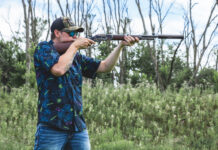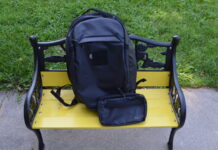
From Chris B.
Being able to quickly draw your gun, acquire your target and fire is a valuable skill which comes in handy for both competitions and self-defense situations.
Far too many gun owners have one routine. They go to the gun range and lackadaisically load their guns, aim and shoot.
They prioritize comfort over technique, but the reality is a self-defense situation isn’t going to be comfortable. If you’re facing a life-or-death situation, you need shooting techniques you can rely on.
Increasing your draw speed is the single-most important part of shooting faster. Follow these tips to see dramatic improvements in how quickly you draw your gun.
1. Develop Solid Fundamentals
If you’re an experienced shooter, you can probably skip this step.
But if you’re still learning the ropes, you’ll want to make sure you have your fundamentals down before you start worrying about how fast you can draw your gun.
There are a few key elements to shooting that should be second nature.
The first is your stance. When shooting, you want to have a slight forward lean to your body with your arms almost fully extended.
Your grip is very important. You should have as firm a grip on the gun as possible without gripping it so hard that your hands begin shaking.
It’s a good idea to grab the gun as high up on it as you can with your shooting hand, and then wrap your support hand around the other side of the handle.
You should be able to line up your sights enough that you can shoot accurately from at least 10 yards away. Handgun scopes, while
Your trigger squeeze should be a smooth process where you don’t jerk the gun at all in anticipation of the recoil.
2. Reduce the Number of Decisions You Make
Cutting down on how many decisions you need to make is critical for increasing your draw and shooting speed.
Now, at first glance, shooting may not seem like a situation where you make many decisions. However, most shooters make quite a few small, split-second decisions.
The problem is that each of these split-second decisions makes your shooting a bit slower. And in a life-or-death situation where you’re dealing with an adrenaline rush, these decisions can become even more of an issue.
What kind of decisions are we talking about here? Here are a couple:
How are you going to draw your gun?
How will you release the slide?
Let’s look at these examples, one at a time.
There are two main options for drawing your gun – the draw stroke and the close-quarters draw stroke, also sometimes called the right-angle draw stroke.
The draw stroke involves drawing your gun, holding it pointed down in front of your waist while you put your support hand on it, and then raising it up to acquire your sights.
This won’t work if you have an object in front of you that blocks you from raising the gun, and it will take you an extra moment to acquire your sights upon raising the gun when you use this draw.
With the close-quarters draw stroke, you draw the gun and keep it tight to your body as you bring the support hand over to it. You then acquire your sights as you extend your arms.
Not only does the close-quarters draw work in all situations, but it helps you acquire your sights more quickly.
Given the advantages of the close-quarters draw, that’s the only draw you should train. You don’t want to wonder which draw you should do in a self-defense situation.
When your slide is locked back, you can either use the slide lock to release it or grab the slide and rack it.
The only time you’ll use the slide lock is in this situation, whereas you’ll need to grab the slide to charge the gun otherwise. Since grabbing the slide will work in any situation and using the slide lock will not, you should eliminate using the slide lock from your toolkit.
It’s also smart to always do a tap and rack no matter what action you’re performing with your gun. Loading, reloading, clearing jams – since the tap and rack will work for all of these, stick with that and reduce your number of decisions.
Keeping decisions to a minimum is one reason we recommend guns without manual safeties if your focus is on quick drawing. A safety just takes more valuable time.
Two excellent choices for quick drawing are the Ruger LC9 Pro, designed to meet the needs of law enforcement officers in high-stress situations, and the M&P9 SHIELD No Thumb Safety.
3. Practice Slowly and Smoothly to Start
One of the biggest problems you could encounter when working on your quick draw is trying to do it quickly.
Many shooters are so focused on speed that their movements become jerky.
There’s a common saying used in shooting, martial arts and likely many other areas. It goes “slow is smooth, smooth is fast.”
Even when your aim is a quick draw and fast shooting, don’t try to practice that right away. Instead, work on minimizing your movements.
Make sure you’re drawing your gun correctly and you don’t have any excess movements during the process.
As you go through this procedure, you’ll develop muscle memory and you’ll naturally start to do it more quickly.
If at any point you notice your form is starting to suffer, slow down.
Here’s a good anecdote demonstrating how beneficial it is to be smooth instead of fast:
A shooting instructor set up a course with around 10 targets, and there was quite a bit of movement between shooting positions for each of these targets.
The students, who were all experienced shooters in their own right, ran through the course, trying to do it as quickly as possible.
The instructor walked through the whole course and had the best time by several seconds. While everyone else was focusing on speed, he was focusing on smoothness.
4. Practice Different Drills and Scenarios
If you use the aforementioned techniques to develop a quick draw while you’re at the range, then that will likely be the only place where you have a quick draw.
Obviously, your typical self-defense situation won’t be anything like standing and firing at a paper or steel target.
You’ll be moving around.
You could end up shooting from awkward positions.
Maybe you aren’t able to get in your typical firing stance – you’re on your back, or your knees or one hand is occupied so you can only shoot one-handed.
If you truly want to be good at shooting quickly, you need to practice in different situations.
A video simulator is one way to practice what a real self-defense situation would be like. You can also take classes that focus on shooting in self-defense situations.
Other options include incorporating movement into your shooting, shooting while a partner times you or yells instructions, or shooting in a competition.
Developing Your Skills
When you get your fundamentals down pat, keep your decisions to a minimum, focus on smoothness and practice often, you’ll see significant improvements on how quickly you can draw and fire your gun.
Having the right gun is also important for a quick draw. While you can improve your draw speed with any gun, certain guns are much easier to draw and fire than others.
We mentioned guns with no manual safety earlier, but we also like compact 9mm guns for quick drawing.
The compact size makes the gun easier to draw. The 9mm caliber means there will be less recoil so it’s easier to keep your shots on target.
The Gen 4 Glock 19 is a popular handgun for women who want a gun for quick drawing because of its lightness and easy-to-use ergonomic design.
Whichever gun you choose, get proficient with it until using it feels like second nature.



